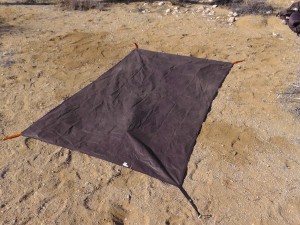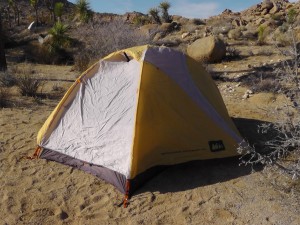
There are a wide variety of tent shapes and sizes, each reflecting the personality and style of their owner.
In spite of their apparent differences, most tents are designed to solve a common fundamental challenge – how to efficiently protect the tent occupant from the elements.
A wilderness shelter can be thought of as a collection of layers, each with a specific purpose.

These typically layers include:
- A relatively flat durable surface to provide stability
- A tarp to serve as a moisture barrier and tent protector
- A main tent body to provide insulation and protection from insects
- Poles to provide structure and strength
- And a rainfly for added protection from rain, sleet and snow

Depending on the weather conditions and your tolerance for adventure, you may or may not deploy all of these layers. If the weather’s great and you like to sleep out under the stars, you may want to use only the tarp. If weather’s great, but mosquitoes aren’t, you may setup a mesh tent with no rain fly. If you are traveling ultra light, you may have only brought the tarp and rainfly, and left the tent body at home.

Regardless of what you deploy in the field, a good understanding of your layer options is critical.
Durable Surface
Selecting an appropriate location for your tent is the first step. You want to make sure the location is safe, not in an area prone to rock slides, water runoff, lightening strikes or falling tree branches.

To decrease your impact on the environment, you should follow the leave no trace principle of camping on durable surfaces. Select an area that is relatively flat. You can remove surface stones, pine cones and sticks, but gone are the days of digging and excavating a tent platform. Do not dig trenches. They scar the environment and rather than protecting you from water runoff are more likely to create miserable muddy trenches and moats.
Moisture Barrier
Once you have established your ground layer, it is time to setup a moisture barrier. There are a variety of tarp options. They may be designed specifically for your tent, including structural elements such as grommets and precise sizing. In general, a tarp should be slightly smaller than your tent. Tarps that stick out from your tent can actually catch rain water and moisture, and channel it right under your tent. That changes your tarp from being a water barrier, to a swimming pool liner. If the tarp is too big, fold it under.

You can create your own tarp from hardware store plastic sheets. 6 mm thickness seems to be a nice balance between durability and weight. I prefer clear plastic tarps because they make it easier to find and remove stray sticks and stones you missed when clearing the ground, but black works fine too. A tarp not only keeps ground moisture from making you cold, it also protects the bottom of your tent from damage and wear. It is much cheaper to replace a tarp than a tent.
Tent Body

Tent bodies come in a variety of shapes and sizes. When removing from the bag pay attention to how it was folded so it will be easier to repack later. Some tents are folded in thirds, some in fourths, etc. When spreading the tent out on the trap arrange the door in the direction you want, usually uphill.
Structure

Every tent needs a structure. It may be old school poles pushing up on the tent, poles feed through sleeves in the tent body, or more popular now, free standing pole structures which the tent body can be clipped to and hung from. Most modern poles have a built in elastic cord which keeps the pieces together and ensure proper alignment. These poles are surprisingly flexible and strong, but fiberglass can break, and metal can bend if mishandled.
Stakes
Some tents require stakes to hold the poles in place, but most modern tents are free standing structures. This means even after erected, the free standing tents can be moved and repositioned. Stakes are required to keep these tents from being blown away in the wind, like giant and expensive tumble weeds. To prevent stakes from being pulled out in the wind, they should be pushed in at an angle, somewhat perpendicular. You may need to reposition the tent slightly if you encounter resistance from underground rocks. Try to avoid pounding stakes into the ground with a rock. They are likely to bend, and weaken. Also, make sure your stakes do not become tripping hazards.
Rain Fly

A rainfly provides an additional layer of protection from severe weather such as rain, sleet and snow. To be effective the rainfly should not come in direct contact with the tent body. Where the rainfly and tent touch, water can seep through. It is important to stake out the rainfly to maintain the proper spacing. To avoid the buildup of condensation, many rainflys and tent bodies have vents. Some rainflys also provide additional protection at the entrance in the form of a vestibule. The patio like covering can serve as a great place to keep your backpack or other gear dry.
Storage
Brush out the tent before taking it down. Free standing tents can be picked up and shaken over your head, letting the debris fall out the unzipped door. Just watch your eyes! Tents stored wet will develop musty mold, shortening their life and making them miserable to sleep in. Whenever possible, tents should be taken down and packed away completely dry.
Before putting a tent back into long term storage, it should be set up in a controlled environment and throughout checked out.
- Wipe down any dirt
- Verify poles are correct and in working order
- Very the number of stakes and tie down ropes
- Check for and make any minor repairs to zippers and seams
- Make sure tarp, tent and rainfly are thoroughly dry before re-packing.
When well maintained a tent should provide years or sound sleeping service.
Practice
These guidelines are generally true for most tents, but you specific setup may be slightly different. Follow the manufacture directions and check out our demonstration videos to see if your specific tent is covered. Better to struggle setting up a tent in the comfort of your own backyard or living room, that to find problems in the wilderness. Practice makes perfect, and will help ensure you pitch a tent, rather than pitching a fit.
